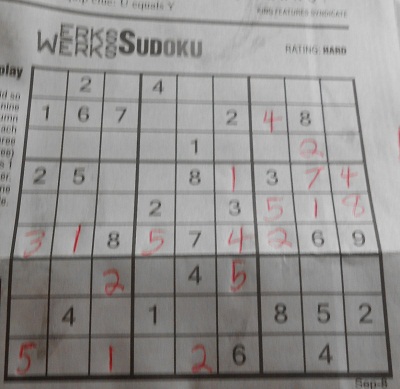Using the "Rules of the Game"

The partially solved Sudoku puzzle shown to the right comes from a Saturday Winnipeg Free Press. Solving these is part of my normal weekend routine. Lately they've been using Erk's Werks Sudoku. At the point shown on the right while solving this puzzle I realized I could use a strategy that I learned from my brother. He suggested using uniqueness as a solver strategy and called it "using the rules of the game". By knowing that there is only one solution for a standard properly constructed puzzle you can sometimes use this method. I actually don't use the method, but it intrigues me and I notice that I very often could.
The main reason that I don't use the method is that I mostly make puzzles rather than solve other people's puzzles. When you're making a puzzle you use the same strategies, but obviously you are proving rather than assuming that the solution is unique. Doing that may be why I'm uncomfortable with the method. It also somehow feels like cheating. Perhaps a practical reason for anybody to be cautious about this method is that non-uniqueness is a fairly common flaw in Sudoku puzzles. By "common" I only mean a see a few per year. These are mostly newspaper Sudokus or obscure website Sudoku's, but occasionally in some of the better books. So assuming the solution is unique is not quite safe. In any case, if you'd like to add this method to your arsenal of methods, here it is...
Step 1
 |
Consider the 3x3 square highlighted in purple. There are 5 empty squares. There are 1's and 6's
that eliminate the same three squares. There are only two squares left that can contain 1 or 6. That means
those two squares can only contain a 1 or a 6. If there was anything else in them there would be
no place to put one of the numbers. Hence, these are the only possibilities:
|
Step 2
 |
Consider the 3x3 square highlighted in purple. There are 5 empty squares. There are only two locations
where a 1 can go, shown below:
|
Step 3
 |
What if one of these 1's possibilities was a 6? That would force the other to be a 1, which would also force the two bottom 1,6 combinations (shown to the left). However, it wouldn't affect anything else in the puzzle if we did this instead.
|
Therefore, if one of these is a solution, both are a solution. If the solution is unique, neither of these tiles can be a 6.
Step 4
How much good does it do to eliminate possibilities? That depends on the puzzle, but eliminating possibilities is a big part of solving Sudoku. In the case of this puzzle as shown at the start, here is what it can do for us:
 |
Consider the row highlighted in purple. Which tile is a 6? Uniqueness eliminated the two marked
with red x's. Two are eliminated by the 6 in the first 3x3 square. Two more are eliminated by 6's in columns.
That leaves only one possibility:
|





